Essay on Value-Based Leadership in AFMC: A Case Study Analysis
VerifiedAdded on 2020/03/01
|7
|1946
|408
Essay
AI Summary
This essay provides a comprehensive analysis of value-based leadership, focusing on the case of Lieutenant General Janet Wolfenbarger and her tenure as Vice Commander of the Air Force Materiel Command (AFMC). It explores how value-based leadership, characterized by motivating subordinates through alignment with organizational goals and personal values, was instrumental in driving structural changes within AFMC. The essay delves into the core principles of value-based leadership, including self-reflection, balancing acts, self-confidence, and general humility, illustrating how Wolfenbarger embodied these traits in the face of opposition. It examines the advantages of this leadership style, such as enhanced leadership quality, problem mitigation, and the fostering of a productive culture, while also acknowledging potential disadvantages like the need for strong leaders and the investment of time and resources. The analysis highlights Wolfenbarger's ability to initiate changes, save costs, and improve processes, concluding that her value-based leadership was crucial for achieving positive outcomes within the rule-based organization of AFMC. The essay references various academic sources to support its arguments and offers valuable insights into leadership in a military context.
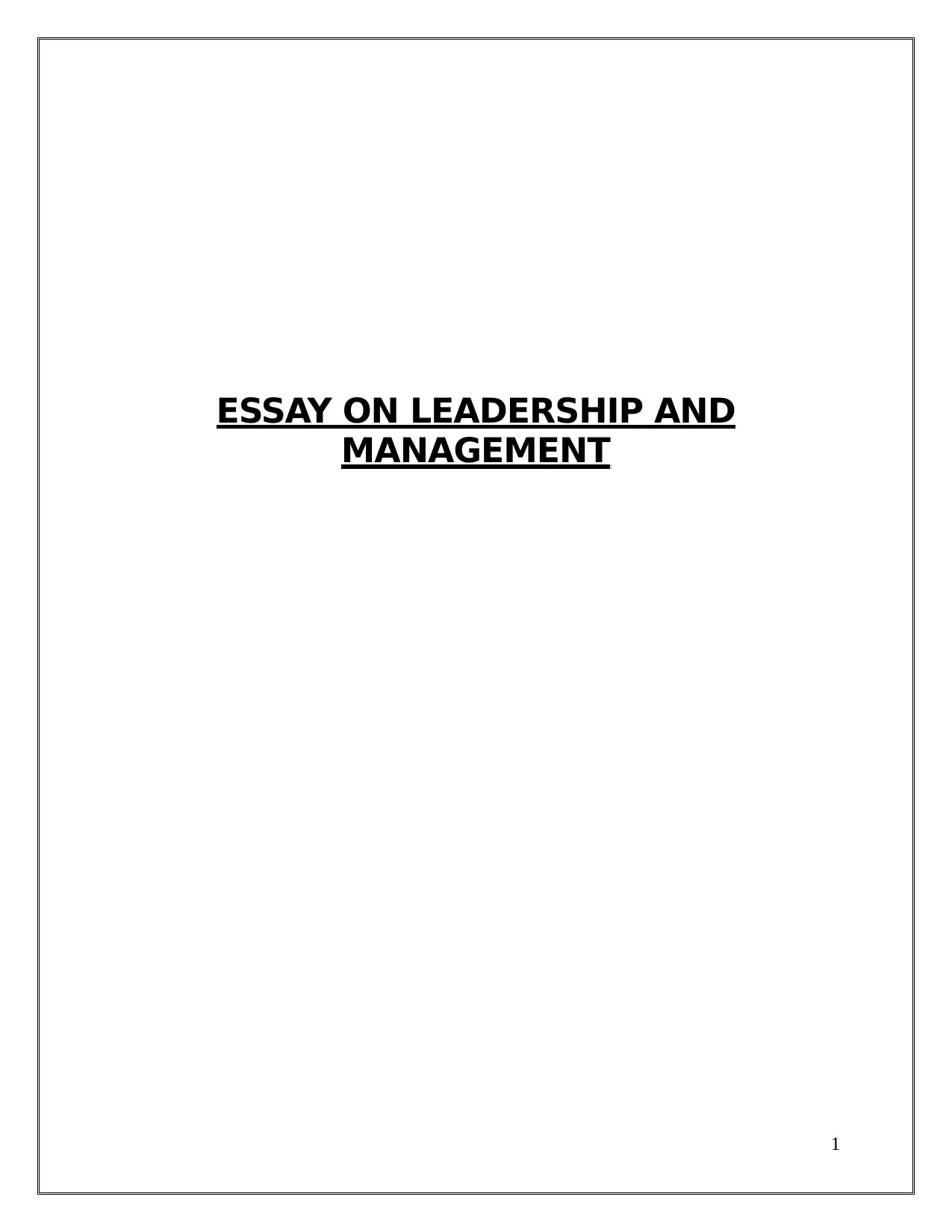
ESSAY ON LEADERSHIP AND
MANAGEMENT
1
MANAGEMENT
1
Paraphrase This Document
Need a fresh take? Get an instant paraphrase of this document with our AI Paraphraser
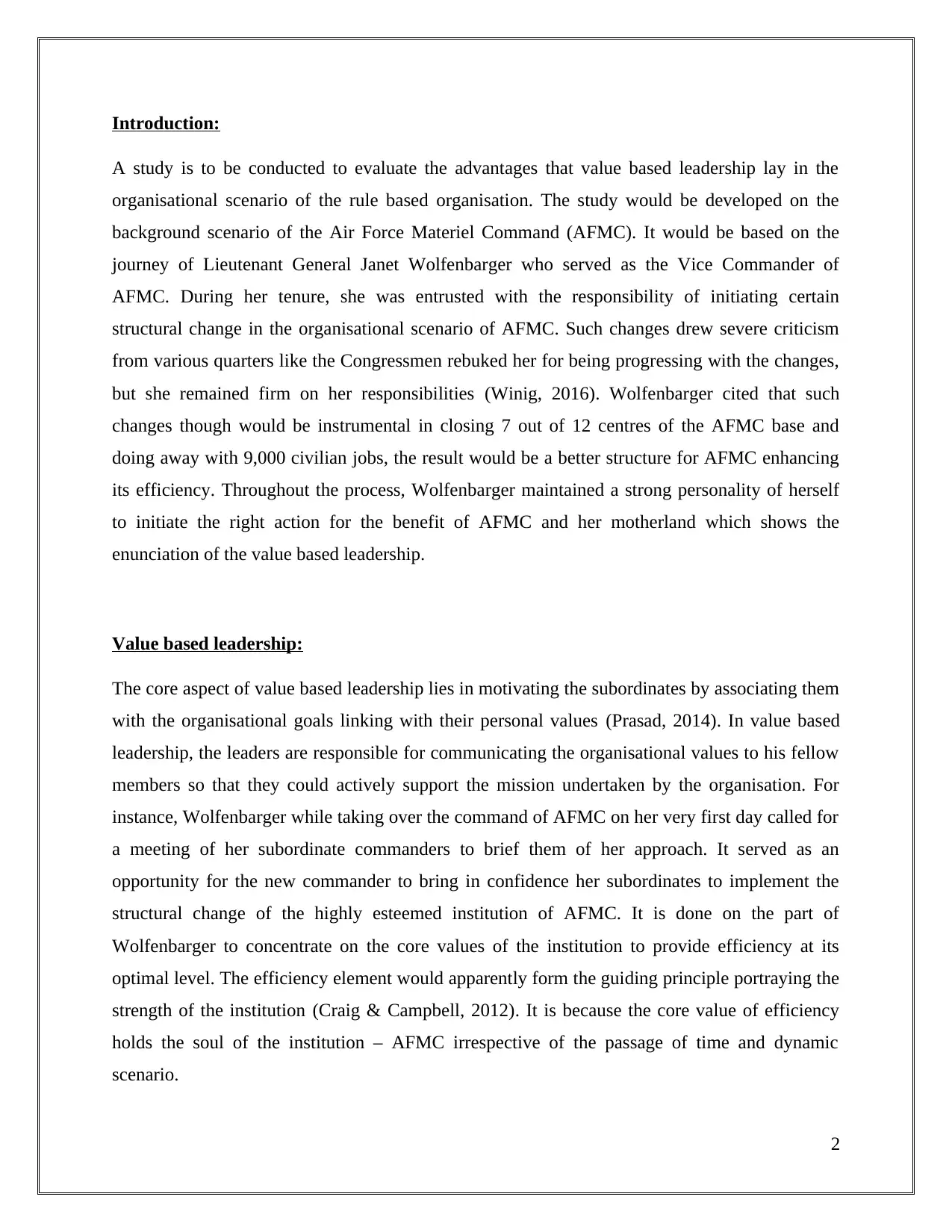
Introduction:
A study is to be conducted to evaluate the advantages that value based leadership lay in the
organisational scenario of the rule based organisation. The study would be developed on the
background scenario of the Air Force Materiel Command (AFMC). It would be based on the
journey of Lieutenant General Janet Wolfenbarger who served as the Vice Commander of
AFMC. During her tenure, she was entrusted with the responsibility of initiating certain
structural change in the organisational scenario of AFMC. Such changes drew severe criticism
from various quarters like the Congressmen rebuked her for being progressing with the changes,
but she remained firm on her responsibilities (Winig, 2016). Wolfenbarger cited that such
changes though would be instrumental in closing 7 out of 12 centres of the AFMC base and
doing away with 9,000 civilian jobs, the result would be a better structure for AFMC enhancing
its efficiency. Throughout the process, Wolfenbarger maintained a strong personality of herself
to initiate the right action for the benefit of AFMC and her motherland which shows the
enunciation of the value based leadership.
Value based leadership:
The core aspect of value based leadership lies in motivating the subordinates by associating them
with the organisational goals linking with their personal values (Prasad, 2014). In value based
leadership, the leaders are responsible for communicating the organisational values to his fellow
members so that they could actively support the mission undertaken by the organisation. For
instance, Wolfenbarger while taking over the command of AFMC on her very first day called for
a meeting of her subordinate commanders to brief them of her approach. It served as an
opportunity for the new commander to bring in confidence her subordinates to implement the
structural change of the highly esteemed institution of AFMC. It is done on the part of
Wolfenbarger to concentrate on the core values of the institution to provide efficiency at its
optimal level. The efficiency element would apparently form the guiding principle portraying the
strength of the institution (Craig & Campbell, 2012). It is because the core value of efficiency
holds the soul of the institution – AFMC irrespective of the passage of time and dynamic
scenario.
2
A study is to be conducted to evaluate the advantages that value based leadership lay in the
organisational scenario of the rule based organisation. The study would be developed on the
background scenario of the Air Force Materiel Command (AFMC). It would be based on the
journey of Lieutenant General Janet Wolfenbarger who served as the Vice Commander of
AFMC. During her tenure, she was entrusted with the responsibility of initiating certain
structural change in the organisational scenario of AFMC. Such changes drew severe criticism
from various quarters like the Congressmen rebuked her for being progressing with the changes,
but she remained firm on her responsibilities (Winig, 2016). Wolfenbarger cited that such
changes though would be instrumental in closing 7 out of 12 centres of the AFMC base and
doing away with 9,000 civilian jobs, the result would be a better structure for AFMC enhancing
its efficiency. Throughout the process, Wolfenbarger maintained a strong personality of herself
to initiate the right action for the benefit of AFMC and her motherland which shows the
enunciation of the value based leadership.
Value based leadership:
The core aspect of value based leadership lies in motivating the subordinates by associating them
with the organisational goals linking with their personal values (Prasad, 2014). In value based
leadership, the leaders are responsible for communicating the organisational values to his fellow
members so that they could actively support the mission undertaken by the organisation. For
instance, Wolfenbarger while taking over the command of AFMC on her very first day called for
a meeting of her subordinate commanders to brief them of her approach. It served as an
opportunity for the new commander to bring in confidence her subordinates to implement the
structural change of the highly esteemed institution of AFMC. It is done on the part of
Wolfenbarger to concentrate on the core values of the institution to provide efficiency at its
optimal level. The efficiency element would apparently form the guiding principle portraying the
strength of the institution (Craig & Campbell, 2012). It is because the core value of efficiency
holds the soul of the institution – AFMC irrespective of the passage of time and dynamic
scenario.
2
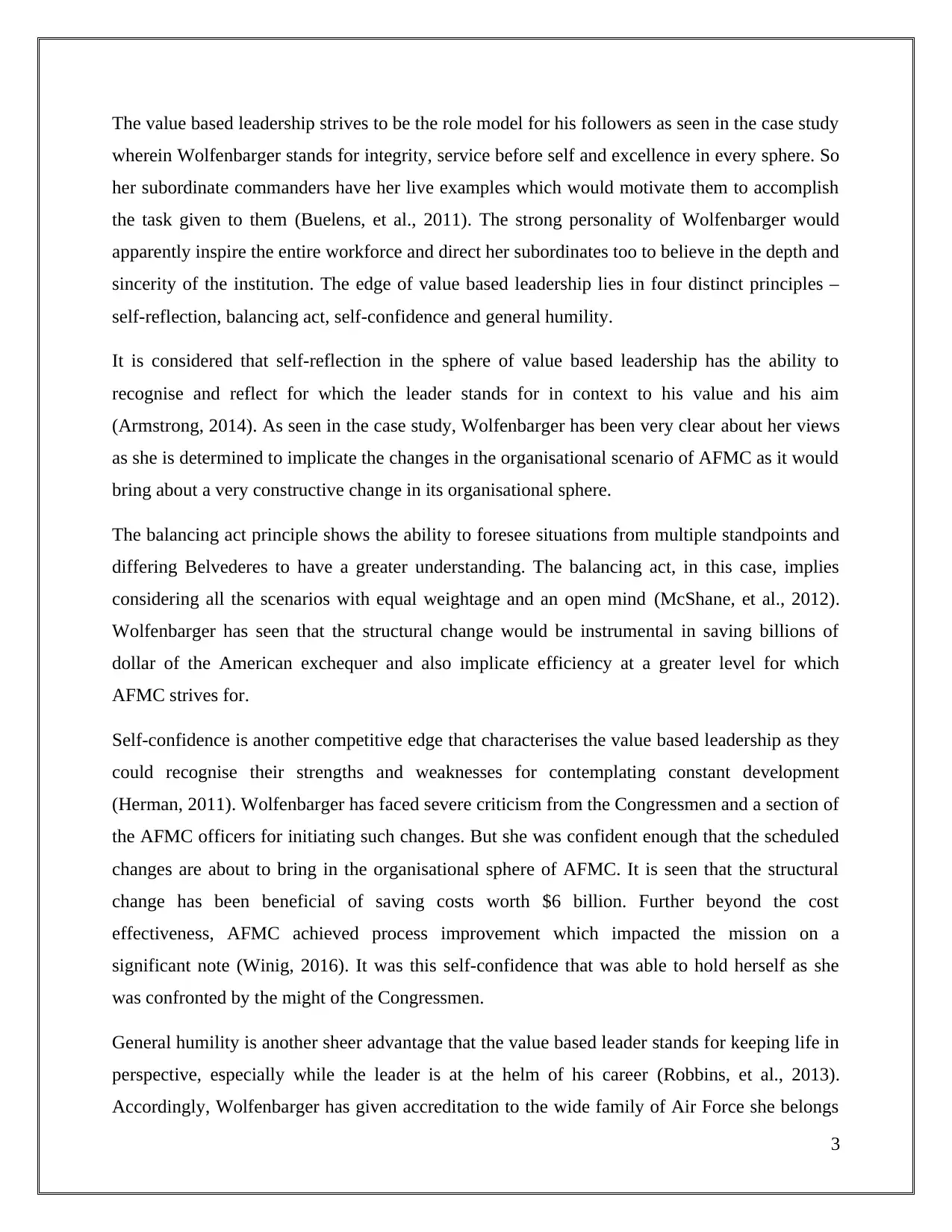
The value based leadership strives to be the role model for his followers as seen in the case study
wherein Wolfenbarger stands for integrity, service before self and excellence in every sphere. So
her subordinate commanders have her live examples which would motivate them to accomplish
the task given to them (Buelens, et al., 2011). The strong personality of Wolfenbarger would
apparently inspire the entire workforce and direct her subordinates too to believe in the depth and
sincerity of the institution. The edge of value based leadership lies in four distinct principles –
self-reflection, balancing act, self-confidence and general humility.
It is considered that self-reflection in the sphere of value based leadership has the ability to
recognise and reflect for which the leader stands for in context to his value and his aim
(Armstrong, 2014). As seen in the case study, Wolfenbarger has been very clear about her views
as she is determined to implicate the changes in the organisational scenario of AFMC as it would
bring about a very constructive change in its organisational sphere.
The balancing act principle shows the ability to foresee situations from multiple standpoints and
differing Belvederes to have a greater understanding. The balancing act, in this case, implies
considering all the scenarios with equal weightage and an open mind (McShane, et al., 2012).
Wolfenbarger has seen that the structural change would be instrumental in saving billions of
dollar of the American exchequer and also implicate efficiency at a greater level for which
AFMC strives for.
Self-confidence is another competitive edge that characterises the value based leadership as they
could recognise their strengths and weaknesses for contemplating constant development
(Herman, 2011). Wolfenbarger has faced severe criticism from the Congressmen and a section of
the AFMC officers for initiating such changes. But she was confident enough that the scheduled
changes are about to bring in the organisational sphere of AFMC. It is seen that the structural
change has been beneficial of saving costs worth $6 billion. Further beyond the cost
effectiveness, AFMC achieved process improvement which impacted the mission on a
significant note (Winig, 2016). It was this self-confidence that was able to hold herself as she
was confronted by the might of the Congressmen.
General humility is another sheer advantage that the value based leader stands for keeping life in
perspective, especially while the leader is at the helm of his career (Robbins, et al., 2013).
Accordingly, Wolfenbarger has given accreditation to the wide family of Air Force she belongs
3
wherein Wolfenbarger stands for integrity, service before self and excellence in every sphere. So
her subordinate commanders have her live examples which would motivate them to accomplish
the task given to them (Buelens, et al., 2011). The strong personality of Wolfenbarger would
apparently inspire the entire workforce and direct her subordinates too to believe in the depth and
sincerity of the institution. The edge of value based leadership lies in four distinct principles –
self-reflection, balancing act, self-confidence and general humility.
It is considered that self-reflection in the sphere of value based leadership has the ability to
recognise and reflect for which the leader stands for in context to his value and his aim
(Armstrong, 2014). As seen in the case study, Wolfenbarger has been very clear about her views
as she is determined to implicate the changes in the organisational scenario of AFMC as it would
bring about a very constructive change in its organisational sphere.
The balancing act principle shows the ability to foresee situations from multiple standpoints and
differing Belvederes to have a greater understanding. The balancing act, in this case, implies
considering all the scenarios with equal weightage and an open mind (McShane, et al., 2012).
Wolfenbarger has seen that the structural change would be instrumental in saving billions of
dollar of the American exchequer and also implicate efficiency at a greater level for which
AFMC strives for.
Self-confidence is another competitive edge that characterises the value based leadership as they
could recognise their strengths and weaknesses for contemplating constant development
(Herman, 2011). Wolfenbarger has faced severe criticism from the Congressmen and a section of
the AFMC officers for initiating such changes. But she was confident enough that the scheduled
changes are about to bring in the organisational sphere of AFMC. It is seen that the structural
change has been beneficial of saving costs worth $6 billion. Further beyond the cost
effectiveness, AFMC achieved process improvement which impacted the mission on a
significant note (Winig, 2016). It was this self-confidence that was able to hold herself as she
was confronted by the might of the Congressmen.
General humility is another sheer advantage that the value based leader stands for keeping life in
perspective, especially while the leader is at the helm of his career (Robbins, et al., 2013).
Accordingly, Wolfenbarger has given accreditation to the wide family of Air Force she belongs
3
⊘ This is a preview!⊘
Do you want full access?
Subscribe today to unlock all pages.

Trusted by 1+ million students worldwide
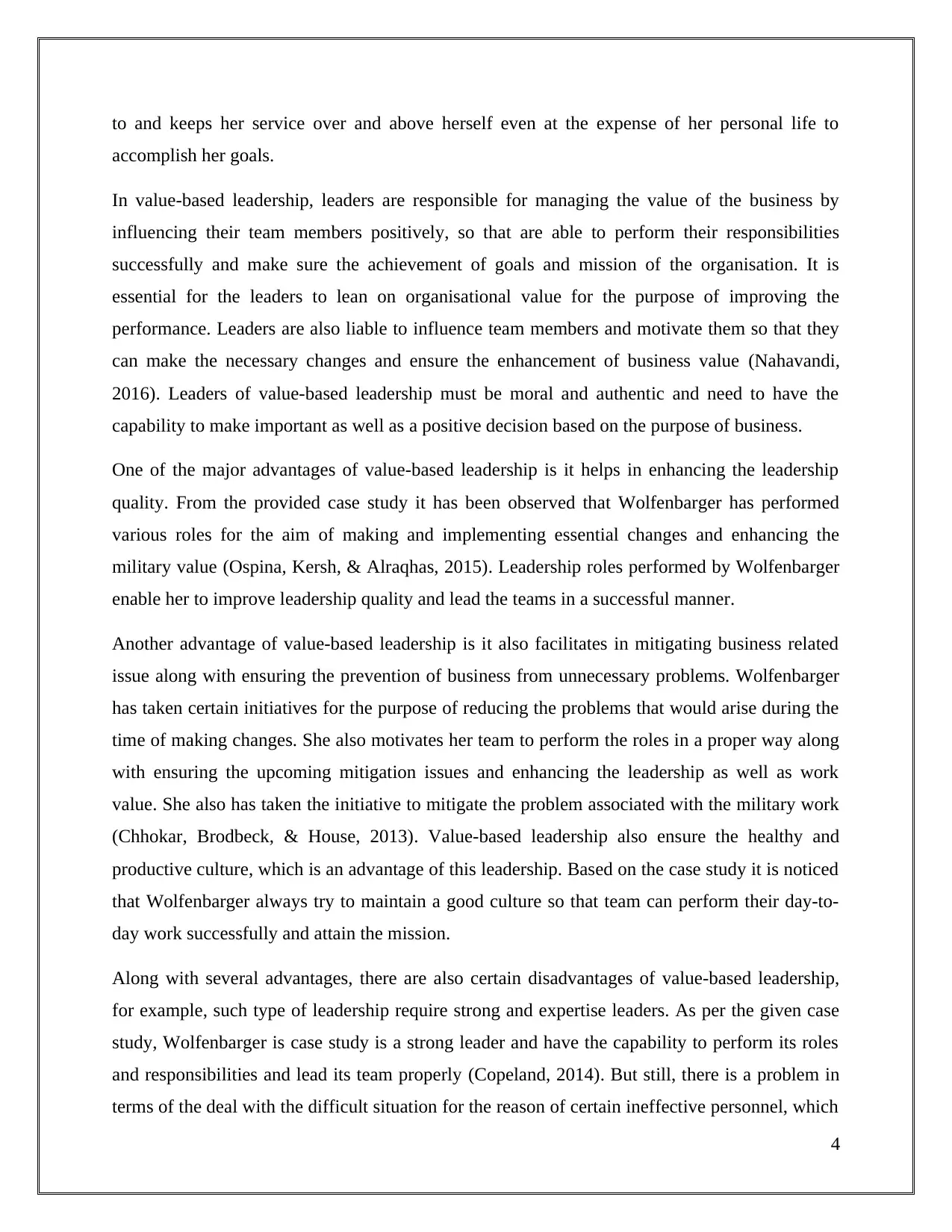
to and keeps her service over and above herself even at the expense of her personal life to
accomplish her goals.
In value-based leadership, leaders are responsible for managing the value of the business by
influencing their team members positively, so that are able to perform their responsibilities
successfully and make sure the achievement of goals and mission of the organisation. It is
essential for the leaders to lean on organisational value for the purpose of improving the
performance. Leaders are also liable to influence team members and motivate them so that they
can make the necessary changes and ensure the enhancement of business value (Nahavandi,
2016). Leaders of value-based leadership must be moral and authentic and need to have the
capability to make important as well as a positive decision based on the purpose of business.
One of the major advantages of value-based leadership is it helps in enhancing the leadership
quality. From the provided case study it has been observed that Wolfenbarger has performed
various roles for the aim of making and implementing essential changes and enhancing the
military value (Ospina, Kersh, & Alraqhas, 2015). Leadership roles performed by Wolfenbarger
enable her to improve leadership quality and lead the teams in a successful manner.
Another advantage of value-based leadership is it also facilitates in mitigating business related
issue along with ensuring the prevention of business from unnecessary problems. Wolfenbarger
has taken certain initiatives for the purpose of reducing the problems that would arise during the
time of making changes. She also motivates her team to perform the roles in a proper way along
with ensuring the upcoming mitigation issues and enhancing the leadership as well as work
value. She also has taken the initiative to mitigate the problem associated with the military work
(Chhokar, Brodbeck, & House, 2013). Value-based leadership also ensure the healthy and
productive culture, which is an advantage of this leadership. Based on the case study it is noticed
that Wolfenbarger always try to maintain a good culture so that team can perform their day-to-
day work successfully and attain the mission.
Along with several advantages, there are also certain disadvantages of value-based leadership,
for example, such type of leadership require strong and expertise leaders. As per the given case
study, Wolfenbarger is case study is a strong leader and have the capability to perform its roles
and responsibilities and lead its team properly (Copeland, 2014). But still, there is a problem in
terms of the deal with the difficult situation for the reason of certain ineffective personnel, which
4
accomplish her goals.
In value-based leadership, leaders are responsible for managing the value of the business by
influencing their team members positively, so that are able to perform their responsibilities
successfully and make sure the achievement of goals and mission of the organisation. It is
essential for the leaders to lean on organisational value for the purpose of improving the
performance. Leaders are also liable to influence team members and motivate them so that they
can make the necessary changes and ensure the enhancement of business value (Nahavandi,
2016). Leaders of value-based leadership must be moral and authentic and need to have the
capability to make important as well as a positive decision based on the purpose of business.
One of the major advantages of value-based leadership is it helps in enhancing the leadership
quality. From the provided case study it has been observed that Wolfenbarger has performed
various roles for the aim of making and implementing essential changes and enhancing the
military value (Ospina, Kersh, & Alraqhas, 2015). Leadership roles performed by Wolfenbarger
enable her to improve leadership quality and lead the teams in a successful manner.
Another advantage of value-based leadership is it also facilitates in mitigating business related
issue along with ensuring the prevention of business from unnecessary problems. Wolfenbarger
has taken certain initiatives for the purpose of reducing the problems that would arise during the
time of making changes. She also motivates her team to perform the roles in a proper way along
with ensuring the upcoming mitigation issues and enhancing the leadership as well as work
value. She also has taken the initiative to mitigate the problem associated with the military work
(Chhokar, Brodbeck, & House, 2013). Value-based leadership also ensure the healthy and
productive culture, which is an advantage of this leadership. Based on the case study it is noticed
that Wolfenbarger always try to maintain a good culture so that team can perform their day-to-
day work successfully and attain the mission.
Along with several advantages, there are also certain disadvantages of value-based leadership,
for example, such type of leadership require strong and expertise leaders. As per the given case
study, Wolfenbarger is case study is a strong leader and have the capability to perform its roles
and responsibilities and lead its team properly (Copeland, 2014). But still, there is a problem in
terms of the deal with the difficult situation for the reason of certain ineffective personnel, which
4
Paraphrase This Document
Need a fresh take? Get an instant paraphrase of this document with our AI Paraphraser
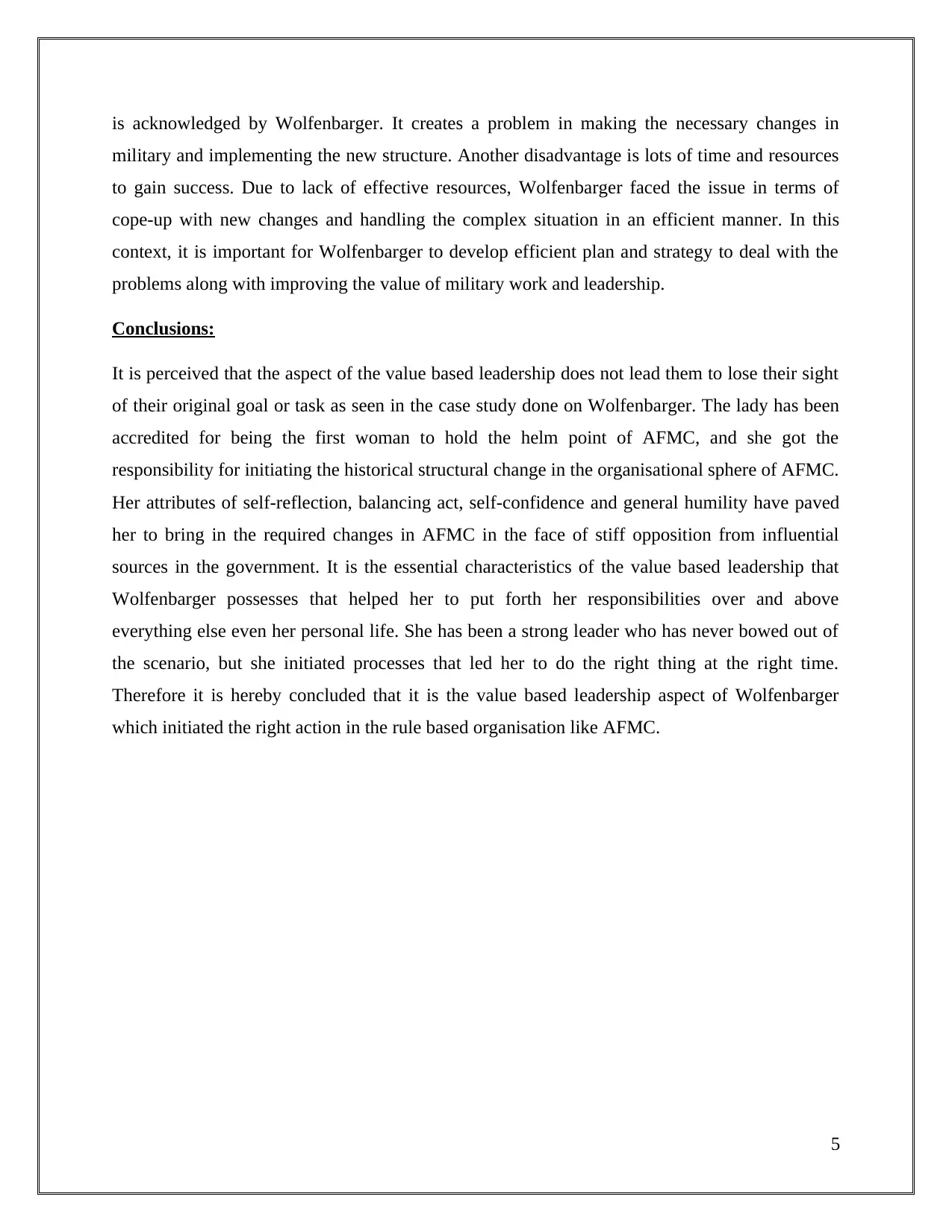
is acknowledged by Wolfenbarger. It creates a problem in making the necessary changes in
military and implementing the new structure. Another disadvantage is lots of time and resources
to gain success. Due to lack of effective resources, Wolfenbarger faced the issue in terms of
cope-up with new changes and handling the complex situation in an efficient manner. In this
context, it is important for Wolfenbarger to develop efficient plan and strategy to deal with the
problems along with improving the value of military work and leadership.
Conclusions:
It is perceived that the aspect of the value based leadership does not lead them to lose their sight
of their original goal or task as seen in the case study done on Wolfenbarger. The lady has been
accredited for being the first woman to hold the helm point of AFMC, and she got the
responsibility for initiating the historical structural change in the organisational sphere of AFMC.
Her attributes of self-reflection, balancing act, self-confidence and general humility have paved
her to bring in the required changes in AFMC in the face of stiff opposition from influential
sources in the government. It is the essential characteristics of the value based leadership that
Wolfenbarger possesses that helped her to put forth her responsibilities over and above
everything else even her personal life. She has been a strong leader who has never bowed out of
the scenario, but she initiated processes that led her to do the right thing at the right time.
Therefore it is hereby concluded that it is the value based leadership aspect of Wolfenbarger
which initiated the right action in the rule based organisation like AFMC.
5
military and implementing the new structure. Another disadvantage is lots of time and resources
to gain success. Due to lack of effective resources, Wolfenbarger faced the issue in terms of
cope-up with new changes and handling the complex situation in an efficient manner. In this
context, it is important for Wolfenbarger to develop efficient plan and strategy to deal with the
problems along with improving the value of military work and leadership.
Conclusions:
It is perceived that the aspect of the value based leadership does not lead them to lose their sight
of their original goal or task as seen in the case study done on Wolfenbarger. The lady has been
accredited for being the first woman to hold the helm point of AFMC, and she got the
responsibility for initiating the historical structural change in the organisational sphere of AFMC.
Her attributes of self-reflection, balancing act, self-confidence and general humility have paved
her to bring in the required changes in AFMC in the face of stiff opposition from influential
sources in the government. It is the essential characteristics of the value based leadership that
Wolfenbarger possesses that helped her to put forth her responsibilities over and above
everything else even her personal life. She has been a strong leader who has never bowed out of
the scenario, but she initiated processes that led her to do the right thing at the right time.
Therefore it is hereby concluded that it is the value based leadership aspect of Wolfenbarger
which initiated the right action in the rule based organisation like AFMC.
5
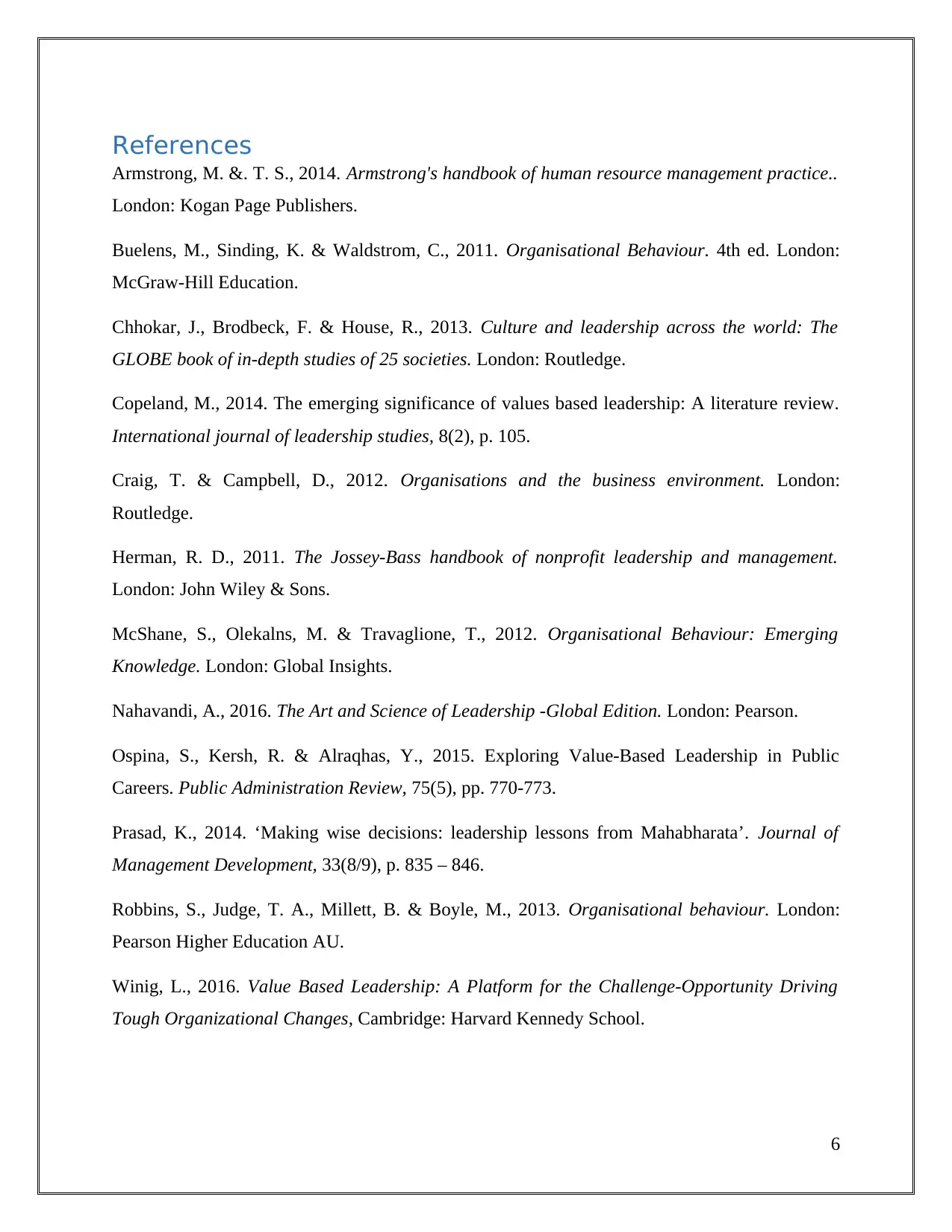
References
Armstrong, M. &. T. S., 2014. Armstrong's handbook of human resource management practice..
London: Kogan Page Publishers.
Buelens, M., Sinding, K. & Waldstrom, C., 2011. Organisational Behaviour. 4th ed. London:
McGraw-Hill Education.
Chhokar, J., Brodbeck, F. & House, R., 2013. Culture and leadership across the world: The
GLOBE book of in-depth studies of 25 societies. London: Routledge.
Copeland, M., 2014. The emerging significance of values based leadership: A literature review.
International journal of leadership studies, 8(2), p. 105.
Craig, T. & Campbell, D., 2012. Organisations and the business environment. London:
Routledge.
Herman, R. D., 2011. The Jossey-Bass handbook of nonprofit leadership and management.
London: John Wiley & Sons.
McShane, S., Olekalns, M. & Travaglione, T., 2012. Organisational Behaviour: Emerging
Knowledge. London: Global Insights.
Nahavandi, A., 2016. The Art and Science of Leadership -Global Edition. London: Pearson.
Ospina, S., Kersh, R. & Alraqhas, Y., 2015. Exploring Value-Based Leadership in Public
Careers. Public Administration Review, 75(5), pp. 770-773.
Prasad, K., 2014. ‘Making wise decisions: leadership lessons from Mahabharata’. Journal of
Management Development, 33(8/9), p. 835 – 846.
Robbins, S., Judge, T. A., Millett, B. & Boyle, M., 2013. Organisational behaviour. London:
Pearson Higher Education AU.
Winig, L., 2016. Value Based Leadership: A Platform for the Challenge-Opportunity Driving
Tough Organizational Changes, Cambridge: Harvard Kennedy School.
6
Armstrong, M. &. T. S., 2014. Armstrong's handbook of human resource management practice..
London: Kogan Page Publishers.
Buelens, M., Sinding, K. & Waldstrom, C., 2011. Organisational Behaviour. 4th ed. London:
McGraw-Hill Education.
Chhokar, J., Brodbeck, F. & House, R., 2013. Culture and leadership across the world: The
GLOBE book of in-depth studies of 25 societies. London: Routledge.
Copeland, M., 2014. The emerging significance of values based leadership: A literature review.
International journal of leadership studies, 8(2), p. 105.
Craig, T. & Campbell, D., 2012. Organisations and the business environment. London:
Routledge.
Herman, R. D., 2011. The Jossey-Bass handbook of nonprofit leadership and management.
London: John Wiley & Sons.
McShane, S., Olekalns, M. & Travaglione, T., 2012. Organisational Behaviour: Emerging
Knowledge. London: Global Insights.
Nahavandi, A., 2016. The Art and Science of Leadership -Global Edition. London: Pearson.
Ospina, S., Kersh, R. & Alraqhas, Y., 2015. Exploring Value-Based Leadership in Public
Careers. Public Administration Review, 75(5), pp. 770-773.
Prasad, K., 2014. ‘Making wise decisions: leadership lessons from Mahabharata’. Journal of
Management Development, 33(8/9), p. 835 – 846.
Robbins, S., Judge, T. A., Millett, B. & Boyle, M., 2013. Organisational behaviour. London:
Pearson Higher Education AU.
Winig, L., 2016. Value Based Leadership: A Platform for the Challenge-Opportunity Driving
Tough Organizational Changes, Cambridge: Harvard Kennedy School.
6
⊘ This is a preview!⊘
Do you want full access?
Subscribe today to unlock all pages.

Trusted by 1+ million students worldwide

7
1 out of 7
Related Documents
Your All-in-One AI-Powered Toolkit for Academic Success.
+13062052269
info@desklib.com
Available 24*7 on WhatsApp / Email
![[object Object]](/_next/static/media/star-bottom.7253800d.svg)
Unlock your academic potential
Copyright © 2020–2025 A2Z Services. All Rights Reserved. Developed and managed by ZUCOL.





